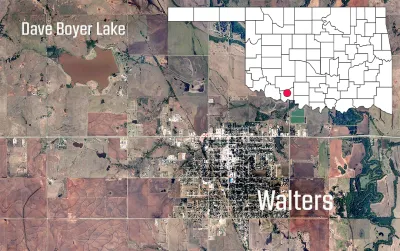Invasive zebra mussels have been detected for the first time in Dave Boyer Lake northeast of Walters in Cotton County, according to the Oklahoma Department of Wildlife Conservation. The mussels were confirmed by ODWC fisheries biologists after recent sampling efforts showed the presence of zebra mussel veligers, or offspring.
Zebra mussels normally grow to about the size of a thumbnail and are named for the striped pattern on their shells. The mussels are typically found attached to surfaces, objects, or other mussels. Zebra mussels affect ecosystems they invade by threatening native mussels, fish and wildlife by consuming available food, and costing taxpayers millions of dollars by clogging water intakes and pipes, and damaging boat engines.
Invasive zebra mussels spread to "clean" waters normally by hitching a ride on boats and other gear that people take from lake to lake. In only two or three years from first arriving, zebra mussels can significantly populate a waterbody.
Fisheries Biologist Elaine Gainer, aquatic nuisance species coordinator for the wildlife department, said once these invasive mussels are present, there is no feasible way to eliminate them. The best strategy is for lake users to take precautions against helping them to spread to other waterbodies, she said.
ODWC’s Aquatic Nuisance Species (ANS) program has confirmed invasive zebra mussels in more than 25 waterbodies throughout Oklahoma, including Kaw, Sooner, Hefner, Keystone, Robert S. Kerr, Grand, Skiatook, Eufaula, Oologah, Claremore, Greenleaf, and Texoma lakes, as well as in the lower Canadian, Cimarron, Arkansas, Verdigris, Washita and North Canadian rivers. Most recently, the invasive species has been confirmed in Tom Steed and Fort Supply reservoirs.
Preventative actions taken by people visiting infested waterbodies is vital to slow or stop the spread of invasive zebra mussels. Using the “Clean, Drain, Dry” procedure is highly encouraged.
To slow the spread, please remember to drain bilge water, live wells, bait buckets and boat motors; inspect boats and trailers when leaving the water; scrape off any mussels or aquatic vegetation found when on dry land; then wash and dry off the boat, trailer and accessories. Also, boats allowed to dry for at least a week after contacting infested water are considered safe to use in a different waterbody. For more information on “Clean, Drain, Dry,” go to StopAquaticHitchhikers.org or wildlifedepartment.com/fishing/ans/zebra-mussel.
Gainer said invasive species of any kind — plant or animal — should never be returned to the water, and any suspected occurrence of an invasive species should be reported to ODWC by submitting a form online at wildlifedepartment.com/wildlife/report-wildlife or by calling 918-200-4815. She urges people to take photos of suspected invasives to help experts with species identification.
Zebra mussels are native to the Caspian Sea region of Asia and are believed to have arrived in the Great Lakes in 1986 via ballast water from a transoceanic ship. They have quickly spread and are now found in more than 30 states.
To learn more about invasive species affecting Oklahoma, go to wildlifedepartment.com/wildlife/field-guide/invasive.
